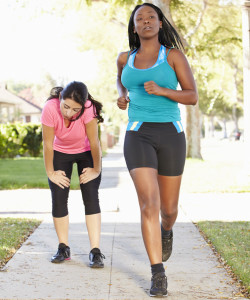
If it’s been a while since you last exercised and you are now out a little of shape, it’s perfectly normal to be out of breath when you start up again. Your cardiovascular and respiratory systems have gotten used to a certain level of daily “work” and now you are taxing them to do more than they are used to by exercising.
It’s going to take a while for them to respond to the extra strain placed upon them. So what can you do to reduce breathlessness during exercise?
What Causes Breathlessness During Exercise?
When you exercise, you’re challenging muscles throughout your body to respond. They sense the additional strain and signal the body for more oxygen and nutrients that can be used for energy to power them.
The only way you can push more liquid through a pipe is to increase the pressure forcing the flow. Your heart rate increases as a response to the request, thus increasing the flow of oxygen-rich blood to the cells through a more rapid heartbeat. The lungs respond by increasing your breathing rate to get more oxygen into the blood and the wastes from the cells back out.
So now that we know the science behind why you’re out of breath, how do we deal with breathlessness during exercise? Time and patience.
Free Report: 6 Risks of a Sedentary LifestyleTime
It takes time to work up to a level where you’re not entirely breathless during exercise. However, it’s normal to have an increased breathing and heart rate when working out. With that said, you should still be able to carry on an abbreviated conversation while exercising once your body has acclimated to it.
After having a full physical exam by your doctor, start out slowly. For example, walk or run as far as you can the first time. Next time set your goal to go farther in the same amount of time requiring you to walk or run a little faster than you did the time before.
Each time you do this, you increase your stamina and your body won’t hardly recognize the additional demand being placed on it, meaning it won’t increase your breathing and heart rate as much as it did the last time. Keep doing this until you reach a walk or run goal – time and distance – that you set for yourself.
Patience
Many times, people who are out-of-shape, and most likely overweight, try to do too much too soon. You must slowly work back up to the level where you once were or want to get to now.
As the old saying goes “Rome wasn’t built in a day”, nor should you expect to get in shape that quickly either. It will take a few months (or more) to get to the point where you can exercise without being out of breath right away. However, you don’t want to overdo it either. Keep track of your target heart rate.
Target Heart Rate (THR)
Your THR is a range of the number of beats per minute that you should stay within when exercising. To figure out your THR, you must first know Maximum Heart Rate or MHR, which is 220 minus your age. Now take 70% to 80% of this number and that is the beats per minute range you should stay within when exercising.
For example, if you’re 50 years old, then your MHR would be 170. Your target heart rate range would be 119 to 136 beats per minute (70% and 80%, respectively). An easy way to track your heart rate is to take your pulse for 10 seconds and multiply that number by 6.
The Health Risks of a Sedentary Lifestyle
By increasing the level of exercise though distance travelled, time or intensity, you can slowly work up to a comfortable level of breathing and heart rate and reduce excessive breathlessness during exercise. Schedule your exercise time, make room in your calendar and follow through! If you really want to be healthy, you’ll find ways to become physically active regularly.
There will be days when you begin exercising that you have bad days. You don’t have to be perfect. You just have to keep trying! Check out these 6 serious health risks directly related to a sedentary lifestyle that will give you that motivation to get up and get moving every day.

